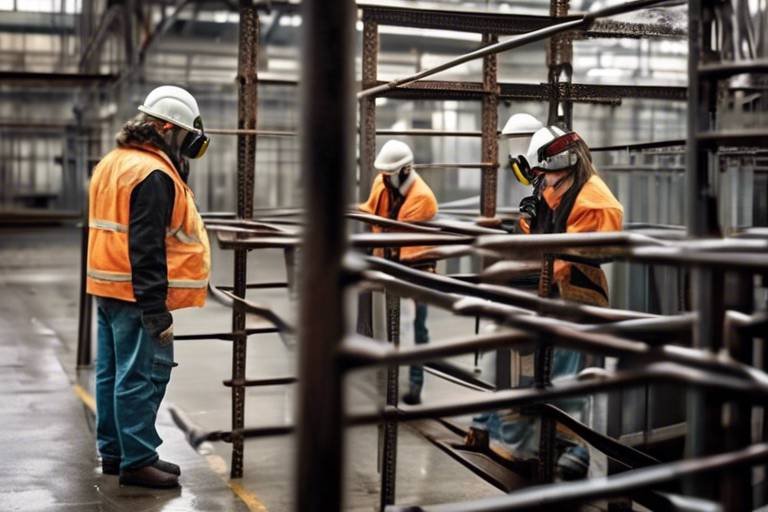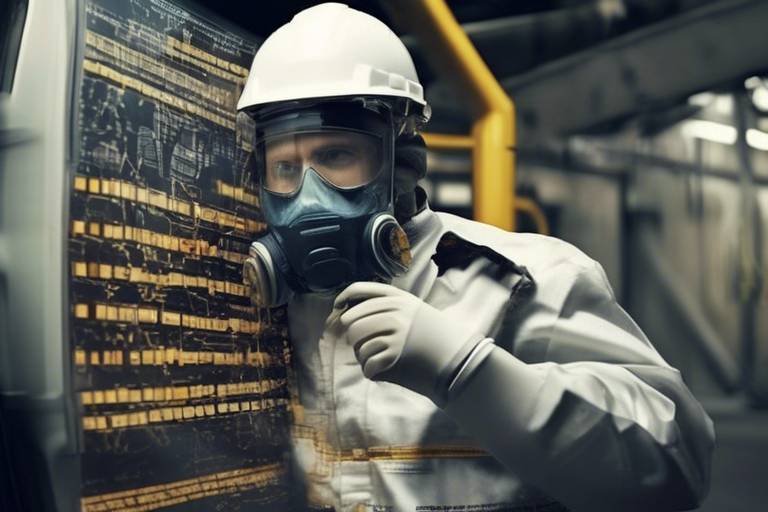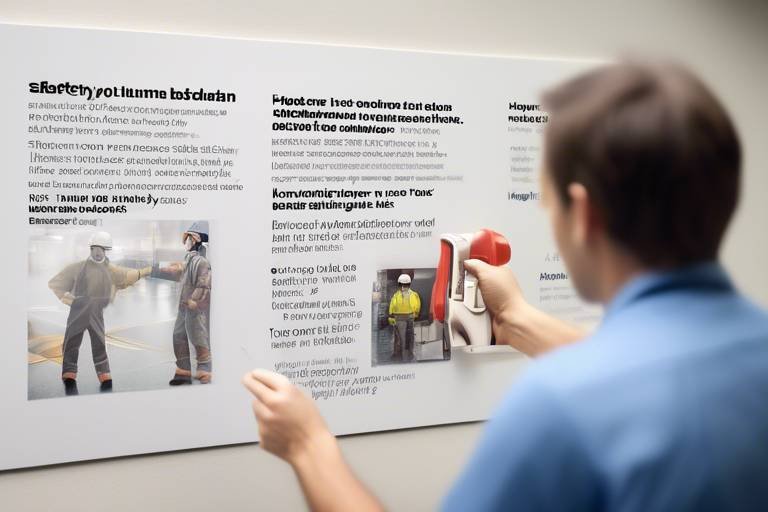What Role does Human Behavior play in Safety Management?
When it comes to safety management, human behavior is often the unsung hero—or villain, depending on the situation. It's fascinating how our thoughts, feelings, and actions can directly influence the effectiveness of safety protocols within an organization. Imagine a well-oiled machine, where every part works in harmony; however, if one component behaves erratically, the entire system can falter. This analogy perfectly encapsulates the importance of understanding human behavior in safety management.
At its core, safety management is not just about rules and regulations; it’s about people. The way employees perceive risks, respond to safety protocols, and engage with one another can significantly impact the overall safety culture of an organization. For instance, if employees feel that their safety concerns are dismissed, they may become disengaged and less likely to follow safety procedures. On the flip side, when workers feel empowered and valued, they are more likely to take ownership of their safety and that of their colleagues.
Furthermore, the attitudes employees hold towards safety can create a ripple effect throughout the organization. Consider this: if a manager consistently demonstrates a lack of concern for safety, what message does that send to the team? It’s like a parent who tells their child not to smoke while puffing away on a cigarette. The disconnect between words and actions can erode trust and lead to unsafe practices. Hence, it’s critical for leaders to model safe behaviors and foster an environment where safety is prioritized.
Understanding the psychological aspects of safety behavior is also crucial. For example, risk perception plays a significant role in how individuals approach safety. If someone perceives a task as low-risk, they might overlook essential safety measures. On the other hand, if they view a situation as dangerous, they may become overly cautious, potentially hindering productivity. This complex interplay of perception and behavior underscores the need for comprehensive training and education to help employees recognize and respond appropriately to risks.
In summary, human behavior is the backbone of effective safety management. By focusing on the psychological factors that influence actions, fostering a strong safety culture, and engaging employees in safety discussions, organizations can create a safer work environment. As we dive deeper into the nuances of safety management, it becomes clear that the path to safety is paved with understanding, communication, and a commitment to continuous improvement.
- What is the importance of human behavior in safety management? Human behavior is crucial as it influences how safety protocols are perceived and followed by employees.
- How can leadership impact safety culture? Leadership can significantly shape safety culture by modeling safe behaviors and prioritizing safety in policies and practices.
- What role does training play in safety management? Training equips employees with the knowledge and skills necessary to recognize and respond to safety risks effectively.
- How can organizations measure the success of their safety programs? Organizations can measure success through key performance indicators, such as the number of incidents reported and employee engagement levels.

The Psychology of Safety
When we think about safety management, we often focus on rules, regulations, and protocols. However, the underlying factor that can make or break these systems is human behavior. Understanding the psychology of safety is crucial because it directly influences how individuals perceive risks and respond to safety measures. It’s like trying to navigate a maze blindfolded; if you don’t understand the layout (or in this case, the psychological factors), you’re bound to hit a wall.
One of the primary aspects of safety psychology is risk perception. This refers to how individuals assess the dangers associated with a task or environment. For example, a construction worker might underestimate the risks of working at heights if they’ve done it many times without incident. This leads to a false sense of security, which can be detrimental. On the flip side, someone new to the job may overestimate risks and become overly cautious, potentially hindering their performance. Understanding these perceptions is vital for safety managers who aim to tailor their training programs effectively.
Another critical component is motivation. What drives people to adhere to safety protocols? Is it fear of punishment, a desire to be safe, or perhaps a sense of responsibility towards their colleagues? The answer varies from person to person. For instance, employees who feel a strong connection to their team are often more motivated to follow safety guidelines because they recognize that their actions impact others. This highlights the importance of fostering a sense of community within the workplace.
Moreover, psychological theories such as the Health Belief Model and Social Learning Theory can provide insights into safety behavior. The Health Belief Model suggests that individuals are more likely to engage in safe practices if they believe they are susceptible to a threat and that taking action will effectively reduce that threat. Meanwhile, Social Learning Theory emphasizes the role of observing others. When employees see their peers practicing safety, they are more likely to imitate those behaviors, creating a ripple effect throughout the organization.
In summary, the psychology of safety encompasses various factors that influence how individuals perceive and react to risks. By understanding these components, organizations can develop more effective safety management strategies that not only comply with regulations but also resonate with the human element. After all, at the end of the day, safety is not just about following rules; it's about cultivating a mindset that values and prioritizes well-being.
- What is risk perception? Risk perception is how individuals assess the dangers associated with a task or environment, which can significantly influence their safety behaviors.
- How does motivation affect safety behavior? Motivation can drive individuals to adhere to safety protocols, influenced by personal responsibility, fear of consequences, or a sense of community.
- What are the key psychological theories related to safety? The Health Belief Model and Social Learning Theory are two key psychological frameworks that help explain safety behaviors and motivations.

Creating a robust safety culture within an organization is not just about implementing rules and regulations; it’s about weaving safety into the very fabric of the workplace. A strong safety culture can significantly reduce accidents and enhance overall employee well-being, but how do we cultivate such an environment? It all starts with understanding that safety is a shared responsibility, and it requires the active participation of everyone, from the top management to the new hires. When leaders prioritize safety and demonstrate a genuine commitment, it sets a powerful example for the entire organization.
Leadership plays a pivotal role in shaping safety culture. Leaders must not only enforce safety protocols but also embody the values they wish to instill. For instance, if leadership is consistently seen wearing personal protective equipment (PPE) and adhering to safety protocols, employees are more likely to follow suit. This modeling of behavior is crucial; it sends a clear message that safety is non-negotiable. Moreover, leaders should actively engage with employees, encouraging them to voice their concerns and suggestions regarding safety practices. This open dialogue fosters trust and collaboration, making employees feel valued and heard.
Communication is another cornerstone of a strong safety culture. Effective communication strategies can bridge gaps and ensure that safety messages resonate with everyone. Regular safety meetings, updates, and training sessions are essential. For example, consider implementing a monthly safety newsletter that highlights best practices, recent incidents, and safety tips. This not only keeps safety at the forefront of employees' minds but also reinforces the idea that safety is a continuous conversation, not a one-time event. Furthermore, utilizing visual aids, such as posters and infographics, can enhance understanding and retention of safety information.
Employee engagement is equally vital in cultivating a safety culture. When employees are actively involved in safety initiatives, they take ownership of their own safety and that of their colleagues. Techniques for fostering this engagement include:
- Involving employees in safety committees.
- Encouraging participation in safety audits and inspections.
- Recognizing and rewarding safe behaviors through incentive programs.
Such initiatives not only empower employees but also create a sense of community around safety, making it a collective goal rather than an individual responsibility. By integrating safety into daily routines and decision-making processes, organizations can create an environment where safety becomes second nature.
In summary, influencing safety culture is a multifaceted endeavor that requires strong leadership, effective communication, and active employee engagement. By prioritizing these elements, organizations can foster a culture where safety is not merely a compliance issue but a core value that drives every action and decision. This transformation not only enhances safety performance but also contributes to a more positive workplace atmosphere, leading to higher morale and productivity.
Q: What is safety culture?
A safety culture refers to the shared values, beliefs, and attitudes regarding safety within an organization. It encompasses how safety is perceived, prioritized, and practiced by all members of the organization.
Q: How can leadership influence safety culture?
Leadership influences safety culture by modeling safe behaviors, communicating the importance of safety, and actively engaging employees in safety initiatives.
Q: Why is employee engagement important in safety management?
Employee engagement is crucial because it fosters ownership of safety practices, encourages participation in safety discussions, and enhances compliance with safety protocols.
Q: What role does communication play in safety culture?
Effective communication ensures that safety messages are clearly conveyed, understood, and retained by employees, creating a continuous dialogue around safety practices.

Leadership is the cornerstone of a robust safety culture within any organization. When leaders prioritize safety, they set the tone for the entire workforce. Imagine a ship navigating through stormy seas; the captain's demeanor and decisions can either steer the crew towards safety or lead them into chaos. In this context, effective leaders act as navigators, guiding their teams through the complexities of safety management.
One of the most significant ways leaders can influence safety is by modeling safe behaviors. Employees are more likely to follow safety protocols when they see their leaders actively engaging in those practices. For example, if a manager consistently wears personal protective equipment (PPE) and adheres to safety guidelines, it sends a powerful message that safety is not just a checkbox but a core value of the organization.
Furthermore, leaders can create and implement policies that prioritize safety. This involves not just writing rules but also fostering an environment where safety is integrated into daily operations. When safety policies are clear and enforced consistently, employees feel more secure and are more likely to comply. As the saying goes, “What gets measured gets managed.” Leaders should regularly assess safety practices and make adjustments as needed, ensuring that safety remains a dynamic part of the organizational culture.
Communication is another critical area where leadership impacts safety. Leaders must ensure that safety messages are clear, consistent, and frequent. Consider the analogy of a sports team; if the coach doesn't communicate the game plan effectively, the players may struggle to execute it. Similarly, in a workplace, if safety protocols aren't communicated well, employees may not understand their importance or how to implement them. Leaders can utilize various communication strategies, such as:
- Regular safety meetings to discuss concerns and updates.
- Digital platforms for sharing safety information and updates.
- Open-door policies that encourage employees to voice safety concerns without fear of retribution.
Moreover, leaders should actively seek feedback from their teams regarding safety practices. This two-way communication fosters a culture of trust and collaboration, making employees feel valued and heard. When employees know their input can lead to tangible changes, they are more likely to engage in safety initiatives actively.
In summary, the impact of leadership on safety management cannot be overstated. Leaders who prioritize safety through their actions, policies, and communication strategies create an environment where employees feel safe and empowered. This engagement not only enhances compliance with safety protocols but also nurtures a culture of continuous improvement, ultimately leading to a safer workplace for everyone.
Q: How can leaders effectively model safe behaviors?
A: Leaders can demonstrate safe behaviors by consistently following safety protocols, using personal protective equipment, and participating in safety training alongside their teams.
Q: What role does communication play in safety management?
A: Effective communication ensures that safety messages are clear and understood by all employees, fostering a culture of safety and encouraging compliance with safety practices.
Q: How can employee feedback improve safety practices?
A: Employee feedback provides valuable insights into potential safety issues and areas for improvement, allowing leaders to make informed decisions that enhance safety protocols.

Effective communication is the backbone of any successful safety management system. Think of it as the oil that keeps the machine running smoothly. Without it, the gears can grind, leading to misunderstandings and, ultimately, unsafe practices. So, how can organizations foster a culture of open communication regarding safety? It starts with establishing clear messaging. It's essential to ensure that safety protocols are not just documented but also communicated in a way that every employee understands. This might include creating visual aids, holding regular safety meetings, or utilizing digital platforms for updates.
Another critical aspect of communication strategies is the feedback mechanism. Imagine a scenario where a worker notices a potential hazard but feels hesitant to report it due to fear of backlash or judgment. This is where a robust feedback system comes into play. By encouraging employees to voice their concerns without fear, organizations can identify and mitigate risks before they escalate. Regularly scheduled feedback sessions can create a safe space for discussions, allowing employees to share their experiences and suggestions for improvement.
Moreover, fostering an atmosphere of open dialogue is crucial. This means not only encouraging employees to speak up but also actively listening to their input. Leaders should make it a point to engage with their teams, asking questions and showing genuine interest in their safety concerns. This two-way communication can enhance trust and transparency, making employees feel valued and more likely to participate in safety initiatives.
To illustrate the importance of effective communication strategies in safety management, consider the following table that outlines key elements:
| Communication Element | Description | Impact on Safety |
|---|---|---|
| Clear Messaging | Ensuring safety protocols are communicated in an understandable manner. | Reduces misunderstandings and promotes adherence to safety practices. |
| Feedback Mechanism | Establishing channels for employees to report hazards or suggestions. | Encourages proactive identification of risks, enhancing overall safety. |
| Open Dialogue | Creating a culture where employees feel comfortable sharing concerns. | Builds trust and promotes a collaborative approach to safety. |
In summary, effective communication strategies are vital for promoting safety within an organization. By focusing on clear messaging, establishing robust feedback mechanisms, and fostering open dialogue, organizations can create a proactive safety culture that not only prevents accidents but also empowers employees to take ownership of their safety and that of their colleagues. After all, when it comes to safety, every voice matters!
- Why is communication important in safety management?
Communication ensures that all employees understand safety protocols, feel comfortable reporting hazards, and are engaged in safety initiatives. - How can I encourage open dialogue about safety?
Encourage regular discussions, provide platforms for feedback, and actively listen to employee concerns to foster an atmosphere of trust. - What role does feedback play in safety?
Feedback helps identify potential hazards, encourages proactive behavior, and allows for continuous improvement in safety practices.

Engaging employees in safety initiatives is not just a checkbox activity; it’s a crucial element that can significantly enhance compliance and foster a sense of ownership among the workforce. When employees feel involved in safety discussions, they are more likely to adhere to safety protocols. So, how do we achieve this level of engagement? One effective approach is through open communication. Regularly scheduled safety meetings can serve as a platform for employees to voice their concerns and suggestions. This two-way dialogue not only empowers them but also gives management valuable insights into potential safety issues.
Another technique is to incorporate safety into daily routines. For instance, starting every team meeting with a brief safety moment can keep safety top-of-mind. This could be as simple as sharing a quick tip, an incident report, or a best practice. By integrating safety into their work lives, employees begin to see it as an essential part of their daily tasks rather than an afterthought.
Moreover, recognition plays a pivotal role in engagement. When employees demonstrate safe behaviors, acknowledging their efforts publicly can reinforce those actions. Consider implementing a reward system where employees can earn points for participating in safety training or reporting hazards. This not only incentivizes safe behavior but also cultivates a culture of safety where everyone is encouraged to contribute.
Furthermore, involving employees in the development of safety protocols can lead to enhanced buy-in. When individuals have a hand in shaping the rules they follow, they are more likely to take those rules seriously. This can be achieved through workshops or brainstorming sessions where employees can collaborate with management to create practical and effective safety measures.
Lastly, utilizing technology can also boost engagement. Mobile apps that allow employees to report safety concerns or access safety resources can streamline communication and make it easier for everyone to stay informed. By leveraging technology, organizations can create a more connected and responsive safety culture.
In summary, engaging employees in safety initiatives requires a multifaceted approach. By fostering open communication, integrating safety into daily routines, recognizing safe behaviors, involving employees in protocol development, and leveraging technology, organizations can enhance employee engagement in safety management. This not only leads to better compliance but also fosters a proactive safety culture where everyone feels responsible for maintaining a safe workplace.
- Why is employee engagement important in safety management? Employee engagement is crucial because it fosters a sense of ownership and responsibility among workers, leading to improved adherence to safety protocols and a proactive safety culture.
- How can open communication enhance safety culture? Open communication allows employees to voice their concerns and suggestions, providing management with valuable insights while making employees feel valued and heard.
- What role does recognition play in promoting safety? Recognition reinforces safe behaviors by acknowledging and rewarding employees who actively participate in safety initiatives, motivating others to follow suit.
- How can technology improve employee engagement in safety? Technology, such as mobile apps, can streamline reporting and communication, making it easier for employees to stay informed and engaged in safety practices.

When it comes to safety management, training and education are not just buzzwords; they are the backbone of an effective safety culture. Imagine trying to navigate a complex maze without a map. That’s what it’s like for employees who haven’t been properly trained in safety protocols. They may know there are hazards around, but without the right knowledge and skills, they’re left guessing how to avoid them. This is where comprehensive training programs come into play.
Training should be more than a one-off event; it needs to be an ongoing process that evolves with the organization and its challenges. Regular training sessions can help reinforce the importance of safety, ensuring that employees keep safety at the forefront of their minds. After all, just like a muscle, safety awareness needs to be exercised regularly to remain strong. Additionally, ongoing education allows for the introduction of new safety protocols and technologies, keeping everyone up-to-date and well-prepared.
Another critical aspect is the method of delivery. Training can take various forms, including:
- Workshops: Interactive sessions that allow for hands-on learning.
- Online Courses: Flexible options that employees can complete at their own pace.
- On-the-Job Training: Real-world experience under the guidance of a mentor.
Each method has its strengths and can cater to different learning styles. For example, some individuals may thrive in a classroom setting, while others may prefer the flexibility of online courses. The key is to offer a variety of training options that engage employees and cater to their unique learning preferences. By doing so, organizations can create a more informed workforce that is better equipped to handle safety challenges.
Moreover, it’s essential to assess the effectiveness of training programs regularly. This can be achieved through evaluations, quizzes, and practical tests that measure how well employees understand safety protocols. Feedback from employees can also provide valuable insights into what works and what doesn’t, allowing organizations to fine-tune their training approaches. A well-structured training program should not only impart knowledge but also inspire a culture of safety where employees feel empowered to speak up about potential hazards.
In conclusion, the role of training and education in safety management cannot be overstated. By investing in comprehensive and ongoing training programs, organizations can foster a culture of safety that not only protects their employees but also enhances overall productivity. After all, a safe workplace is a productive workplace, and when employees feel secure, they are more likely to contribute positively to the organization.
- Why is ongoing training important in safety management? Ongoing training ensures that employees stay updated on the latest safety protocols and practices, reinforcing their knowledge and skills over time.
- What are effective methods of delivering safety training? Effective methods include workshops, online courses, and on-the-job training, catering to different learning styles.
- How can organizations measure the success of their training programs? Organizations can measure success through evaluations, feedback from employees, and monitoring safety performance metrics.

Behavioral safety programs are essential tools in the quest to enhance workplace safety. These programs focus on understanding and modifying individual behaviors to create a safer environment for all employees. At their core, these programs operate on the premise that most workplace incidents are the result of unsafe behaviors rather than unsafe conditions. By addressing the human element, organizations can significantly reduce the likelihood of accidents, injuries, and even fatalities.
One of the key principles behind behavioral safety programs is the concept of observation. Regularly observing employees as they perform their tasks allows safety managers to identify both safe and unsafe behaviors. This process is not about policing workers but rather about understanding their actions in the context of safety. When employees know they are being observed, they are more likely to adhere to safe practices. This creates a positive feedback loop where safe behaviors are reinforced.
Another critical component is feedback. Constructive feedback helps employees recognize areas for improvement while also reinforcing positive behaviors. When feedback is delivered in a supportive manner, it encourages a culture of safety rather than one of blame. For example, if a worker is observed not wearing their safety goggles, instead of reprimanding them, a supervisor might gently remind them of the importance of eye protection and how it can prevent serious injuries. This approach fosters an environment where employees feel valued and are more likely to engage in safe practices.
To illustrate the effectiveness of behavioral safety programs, consider the following
| Company | Before Program | After Program |
|---|---|---|
| Company A | 50 accidents/year | 10 accidents/year |
| Company B | 30 accidents/year | 5 accidents/year |
| Company C | 20 accidents/year | 2 accidents/year |
This table shows a dramatic decrease in workplace accidents after implementing behavioral safety programs. The results speak volumes about the impact that focused behavioral changes can have on overall safety.
Moreover, it is essential to recognize that measuring the success of these programs is crucial for continuous improvement. Organizations need to establish clear metrics to evaluate their behavioral safety initiatives. This could include tracking the number of safety observations made, the frequency of feedback provided, and ultimately, the reduction in accidents. By analyzing these metrics, companies can fine-tune their programs to address any shortcomings and enhance their effectiveness.
In conclusion, behavioral safety programs are a powerful approach to improving workplace safety by focusing on the behaviors of individuals. By incorporating observation and feedback into the safety culture, organizations can create an environment where safety is prioritized, resulting in fewer accidents and a more engaged workforce.
- What is a behavioral safety program? A behavioral safety program aims to modify individual behaviors to enhance workplace safety by observing actions and providing feedback.
- How do these programs reduce accidents? By focusing on safe behaviors and reinforcing them through observation and feedback, organizations can significantly reduce unsafe actions that lead to accidents.
- What metrics should be used to measure success? Key performance indicators may include the number of safety observations, feedback sessions, and the overall reduction in workplace accidents.
- Can behavioral safety programs be applied in any industry? Yes, these programs can be tailored to fit various industries, making them versatile tools for improving safety.

Observation and feedback are like the heartbeat of a successful behavioral safety program. They serve as the foundation for understanding how individuals interact with safety protocols and their environment. When we talk about observation, we mean more than just watching from a distance; it’s about being actively engaged in the safety processes, identifying areas for improvement, and recognizing safe practices that deserve praise. Think of it as a coach observing their players during practice, not just to correct mistakes but also to highlight what’s being done right. This dual approach fosters a culture of continuous improvement.
Regular observation allows organizations to gather valuable data on safety behaviors. By monitoring how employees perform their tasks, safety managers can pinpoint specific behaviors that either contribute to or detract from a safe working environment. This proactive stance is crucial because it shifts the focus from reactive measures—like responding to accidents—to proactive strategies aimed at preventing them. For instance, a construction site manager might notice that workers are not wearing their helmets consistently. By observing this behavior, the manager can address the issue directly before an incident occurs.
Feedback is equally important; it’s the bridge that connects observation to improvement. Constructive feedback should be timely and specific, allowing employees to understand exactly what they did well or where they fell short. Imagine receiving a report card that only says "good job" or "needs improvement" without any context. It's not particularly helpful, right? Instead, feedback should be detailed, explaining the observed behavior and its impact on safety. For example, instead of saying, “You need to wear your helmet,” a more effective approach would be, “I noticed you weren’t wearing your helmet while operating the crane. Wearing it can prevent serious injuries in case of an accident.” This method not only corrects the behavior but also emphasizes the rationale behind the safety rule.
To enhance the effectiveness of observation and feedback, organizations can implement structured processes. For instance, they can establish regular safety audits or peer-to-peer observation programs where employees observe each other’s safety practices and provide feedback. This not only empowers employees to take ownership of their safety but also fosters a sense of teamwork. When employees feel that their input is valued, they are more likely to engage in safe behaviors and contribute to a positive safety culture.
Furthermore, it’s essential to create a non-punitive environment where employees feel safe to report unsafe conditions or behaviors without fear of retribution. When individuals know that their observations will be met with constructive feedback rather than blame, they are more likely to participate actively in the safety management process. This creates a cycle of continuous improvement, where observation leads to feedback, and feedback leads to enhanced safety practices.
In summary, effective observation and feedback are crucial for fostering a culture of safety within organizations. By actively engaging in the monitoring of safety behaviors and providing constructive feedback, organizations can significantly reduce the risk of accidents and enhance overall safety performance. It’s not just about compliance; it’s about creating an environment where safety is a shared responsibility and a fundamental value.
- What is the purpose of observation in safety management?
Observation helps identify unsafe behaviors and practices, allowing organizations to address issues proactively and prevent accidents. - How can feedback improve safety culture?
Constructive feedback reinforces safe practices and encourages employees to take ownership of their safety responsibilities. - What should be included in effective feedback?
Effective feedback should be timely, specific, and focused on both positive behaviors and areas for improvement. - Why is a non-punitive environment important?
A non-punitive environment encourages open communication, allowing employees to report unsafe behaviors without fear, fostering a culture of safety.

Measuring the success of behavioral safety initiatives is not just a box-ticking exercise; it’s a vital part of ensuring that your safety management system is effective and continuously improving. Think of it as a fitness tracker for your organization’s safety culture. Just like you wouldn’t run a marathon without tracking your training progress, you shouldn’t implement safety programs without assessing their impact. So, how do you gauge whether your initiatives are hitting the mark?
First, you need to establish key performance indicators (KPIs) that align with your safety goals. These indicators should be specific, measurable, achievable, relevant, and time-bound (SMART). For instance, you might track the number of near-misses reported, the frequency of safety training sessions, or even employee participation in safety meetings. Here’s a quick table that illustrates some common KPIs for behavioral safety programs:
| KPI | Description |
|---|---|
| Near-Miss Reporting | Number of near-miss incidents reported by employees. |
| Training Completion Rate | Percentage of employees who have completed safety training. |
| Safety Observation Rate | Frequency of safety observations conducted by management. |
| Accident Rate | Number of accidents per 100 employees over a specific period. |
Once you’ve set your KPIs, the next step is to gather data. This can be done through various methods such as surveys, incident reports, and direct observations. Regularly collecting this data allows you to see trends over time and identify areas needing improvement. But remember, data is only as good as the interpretation behind it. You need to analyze the information critically to draw meaningful conclusions.
Another effective method for measuring success is conducting employee feedback sessions. These sessions can be informal but provide invaluable insights into how employees perceive safety measures. Are they feeling more secure? Do they believe that the safety protocols are effective? Engaging employees in this dialogue not only helps you gather qualitative data but also fosters a sense of ownership and accountability among staff.
Lastly, it’s crucial to communicate the results of your evaluations back to the team. Sharing successes and areas for improvement creates a transparent environment where everyone feels involved in the safety journey. This can be done through regular safety meetings, newsletters, or even a dedicated section on your company’s intranet. Remember, when employees see that their feedback leads to real changes, it encourages ongoing participation and commitment to safety practices.
In summary, measuring the success of behavioral safety programs requires a strategic approach that combines quantitative data with qualitative insights. By establishing clear KPIs, gathering comprehensive data, engaging employees, and communicating results, organizations can create a robust safety culture where everyone plays a part in maintaining a safe workplace.
- What are behavioral safety programs?
Behavioral safety programs focus on modifying individual behaviors to enhance safety in the workplace by encouraging safe practices and reducing accidents. - How can I measure the effectiveness of safety training?
Effectiveness can be measured through KPIs such as training completion rates, employee feedback, and incident reports. - Why is employee engagement important in safety management?
Engaged employees are more likely to take ownership of safety protocols, leading to a more proactive safety culture and reduced incidents. - What role does leadership play in safety management?
Leadership is crucial in modeling safe behaviors, creating policies that prioritize safety, and fostering a culture of open communication.
Frequently Asked Questions
- What is the significance of human behavior in safety management?
Human behavior is at the core of safety management. It influences how safety protocols are followed and shapes the overall safety culture within an organization. When employees understand the importance of safety and are motivated to adhere to protocols, the likelihood of accidents decreases significantly.
- How does psychological understanding improve safety practices?
Understanding the psychology behind safety behaviors—like risk perception and motivation—can greatly enhance safety practices. By recognizing how individuals think and feel about risks, management can tailor safety programs that resonate with employees, ultimately leading to better compliance and safer workplaces.
- What role does leadership play in fostering a safety culture?
Leadership is crucial in establishing and maintaining a strong safety culture. Leaders set the tone by modeling safe behaviors, communicating the importance of safety, and implementing policies that prioritize employee well-being. Their commitment to safety encourages others to follow suit.
- Why is effective communication important in safety management?
Effective communication ensures that safety messages are clear and understood by all employees. It fosters an environment where feedback is encouraged, and open dialogue is the norm. This transparency helps identify potential hazards and promotes a proactive approach to safety.
- How can employee engagement enhance safety initiatives?
Engaging employees in safety discussions and decision-making processes creates a sense of ownership and accountability. When employees feel involved, they are more likely to adhere to safety protocols and contribute to a culture of safety, leading to fewer accidents and a healthier work environment.
- What is the importance of training and education in safety management?
Ongoing training and education are vital for instilling safe practices among employees. They not only equip staff with the necessary skills to perform their jobs safely but also reinforce the importance of safety in everyday operations, making it a fundamental aspect of the workplace culture.
- What are behavioral safety programs?
Behavioral safety programs focus on changing individual behaviors to improve safety outcomes. By addressing the specific actions that lead to accidents, these programs aim to cultivate safer habits and practices among employees, ultimately reducing the risk of incidents.
- How does observation and feedback contribute to safety?
Regular observation and constructive feedback are essential for reinforcing safe behaviors. By monitoring employees and providing timely feedback, organizations can identify areas for improvement and encourage positive safety practices, creating a culture of continuous improvement.
- What methods can be used to measure the success of safety programs?
To evaluate the effectiveness of safety programs, organizations can use key performance indicators (KPIs) such as incident rates, employee feedback, and compliance levels. Regular assessments help identify successes and areas needing attention, ensuring ongoing enhancement of safety initiatives.



















